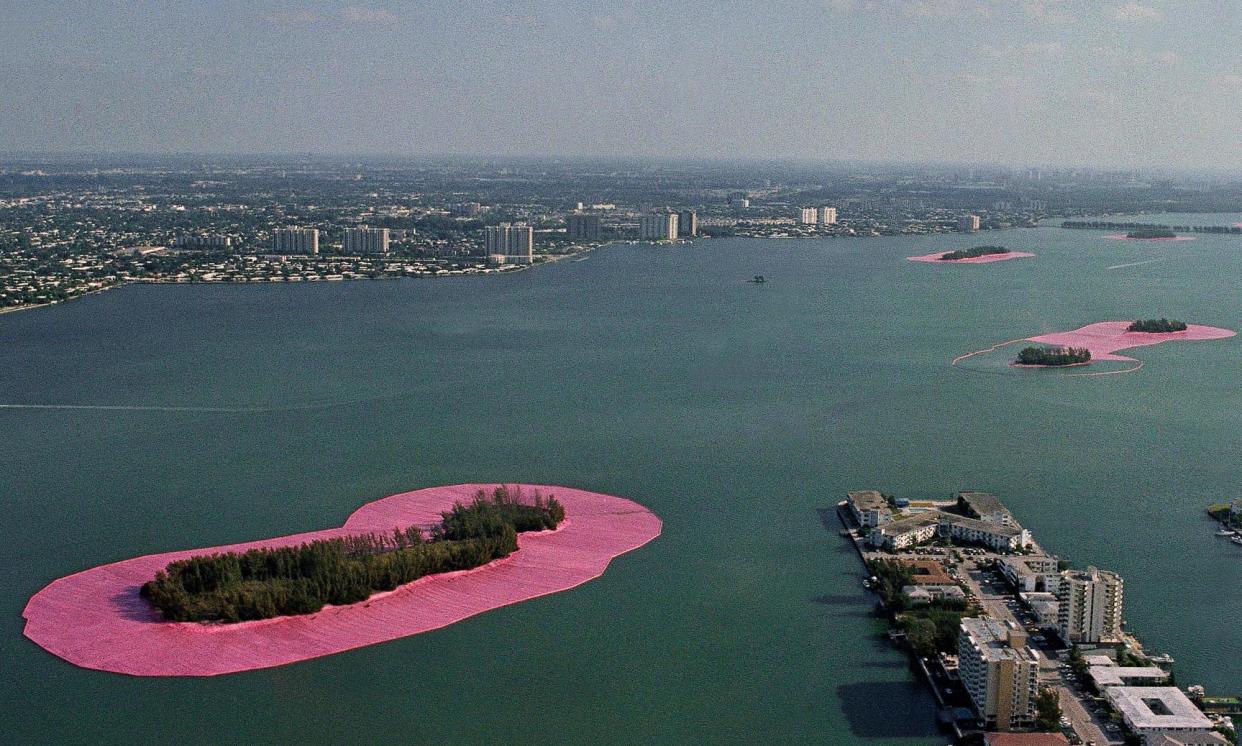From Banksy’s green leaves to Miami’s pink islands, public art’s a party – and everyone’s invited!

Last week, I took my five-year-old nephew to see the new Banksy in London. As we were walking, I told him it was a new, magical tree that had suddenly appeared overnight, put up by a masked man, and that it was up to us to solve the mystery. He came up with all sorts of theories.
When we got there, crowds of people were arriving by bike and on foot, or slowing down as they passed in their cars – people of all ages and backgrounds. Like us, they were marvelling at the new green splattered wall that, from some angles, looks like a tree in full bloom. People were conversing, asking each other their thoughts, spotting the stencilled outline of a person holding a pressure hose next to the tree, or imagining how the artist was able to construct it so secretly.
This artwork will change with the seasons: concealed in summer as if hiding away, only to reveal itself again in winter
The strength of the painting lies in its ability to accentuate the recently pollarded cherry tree in front of it. By being painted in March, it gets us to pay close attention to the minuscule sprouts on the (currently leafless) cherry tree’s branches that will soon be covered in wild, pink blossom. I love how this artwork will change with the seasons: concealed in summer as if hiding away, only to reveal itself once again in winter.
Public art can have a social and political agenda. It gets us to think about who and what lives around it, and how much that landscape might have changed. Between 1999 and 2001, the New York-based artist Ellen Harvey took to the streets to paint 40 tiny, meticulously rendered landscapes reminiscent of the European old masters. Painted on graffiti sites, subway signs or traffic control boxes, each work was made in an oval shape evocative of a Claude glass, those dark convex mirrors that were popular with tourists in the 18th century, allowing them to reflect and frame fine views.
Called The New York Beautification Project, this was intended to be a “love letter to everyone who’s wanted to make a city more beautiful”, as Harvey told me. But it also spoke poignantly to what the city once was. If you held up a Claude glass there today, what would you find? A plethora of skyscrapers and developments, with few trees in sight. Like Banksy, Harvey makes us realise the rarity and sacredness of green spaces in urban environments – and the urgent need to protect them.
Taking public art to an almost impossibly expansive scale, Jeanne-Claude and her husband Christo dedicated their lives to literally embracing nature, coating entire coasts of archipelagos in bright pink fabric, wrapping trees in parks in Switzerland and Australia, and installing a giant orange curtain across a valley and over a highway in Colorado. It was an eye-popping way of prioritising the environment, a means of treasuring it, or even mummifying it, as if it was about to be dispatched to a higher place.
Public art requires us to be present, to bring it to life with our imaginations, to think about how it was constructed, what its location looked like before, and how the art ties in with what already exists – all tools we can use for dreaming up a better world.
By being physically present in our streets, parks, valleys and coastlines, public art can spark vital conversations
In 1996, Yoko Ono put these tools into action with her Wish Tree series, which has since been exhibited across the globe, from Dublin to San Francisco. They are currently on view outside Music of the Mind, her show at Tate Modern in London. Providing participants with pens, paper, a tree and string, Ono offered the following instruction: “Make a wish. Write it down on a piece of paper. Fold it and tie it around a branch of a Wish Tree. Ask your friends to do the same. Keep wishing. Until the branches are covered with wishes.” Not only does joining in get us to think more positively but, like Banksy and Harvey, Ono makes us question what qualifies as art, what it can or should look like, where it can appear and who it is for.
This is public art’s great strength: it’s a celebration of communal looking.. Everyone is able to participate/contribute on an equal basis, engaging in the work however best suits them, no matter what their age or level of artistic knowledge – from those driving past slowly to those who stop and find the time to make a wish. By being physically present in our streets, parks, valleys and coastlines, it can spark vital conversations about the state of society. But it is often ephemeral – not a single one of Harvey’s landscapes exists today. This encourages us to cherish the limited time we have with it.
In a world of increasing smartphone addiction and loneliness, public art can provide a sense of togetherness, community and play. It can bring unexpected joy to commuters, show children that their opinion – and participation in society – matters, and that everyone is invited to this magical thing we call art.


